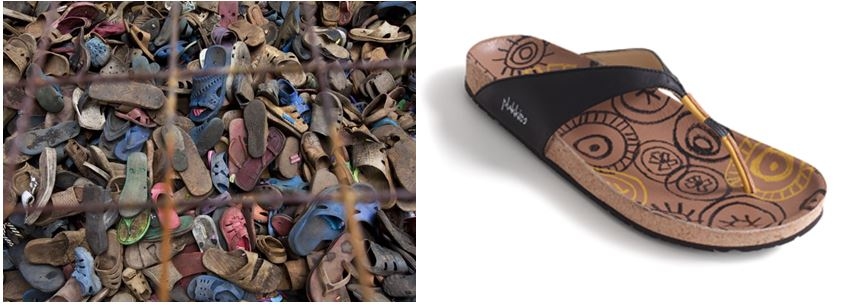A travel through South-Africa shows contrasts in landscape and city areas, but also in people, cultural habits and religion. Educated people living in cities and following luxury lifestyles, live almost like western people, while some other people staying at the countryside, are still living by the old traditions and religions. Innovations are set up and developed in cities, but does the inspiration also comes from these areas? The creativity and ideas of the people living at the countryside inspire the business market in the Johannesburg or Cape town. African fabrics are used for many different garments, traditional music is recorded and available online, recycled tires, plastics or thatch is used for souvenirs. Arriving back home from a travel through South-Africa, people wear flip-flops made out of thatch and collared African scarves. Unfortunately, a few weeks later the memorable feeling of the special experience in South-Africa is shrinking more and more and meanwhile the souvenirs got broken. At that time the Plakkies flip-flops pop up in the Beienkorf. How do African traditions got implemented in mass production? And what made the innovation of the Plakkie so strong?
An impression of good life arrives by the idea of African villages where women are weaving together, preparing and eating food with their families and where people are making music. Tradition is guiding them in daily life. Even though this seems to be relaxing, these cultures have their worries as well. Parents are concerning about money for themselves and their children. Since the last couple of years, the mobility of people has increased and the popularity of travelling expanded. Western travellers are making organised trips with 'local' guides who show them the insights of the country in a few days. To give the Western travellers a satisfied feeling about 'having seen the whole country', countryside visits are inclusive the trip. Western travellers are eating and dancing together with the African locals and get a 'real impression' of a normal day on the countryside. African locals are just trying to accept this interesting hype, but they are playing a smart role in it as well. Locals take the chance to make money out of it. The traditional products that are used in daily life, the creative work arts, fabric and the spices are wanted by tourists. This are the products tourist want to take home, to have a touchable memory and something to give or show others at home. At this local level people earn money out of selling this stuff. The quality of the products is not like the Western quality people are used to. So the memorable product don't last long.
A few years ago a Dutch TU Delft student came up with the idea to develop a flip-flop fabric in South-Africa. His aim was to create structural employment with it, in one of the lowest social and economical areas of the country. His vision was that it was important to build up a corporation within a production of high standard quality products. Plakkies offers good working conditions to their workers and a salary that is enough for himself and 10 others. The sales of traditional products for the Western world is taken away from the countryside. The locals are still playing a role in this business model. Designs of patterns are made by the people where it originally comes from. Furthermore Plakkies doesn't take advantage of the natural resources of the areas. The Plakkie makes use of the old car tires, which were burned before and only delivered toxic gasses. Finally the produced flip-flop got transported to Europe where it got sold in warehouses, and where it gives Western people using it the feeling of, sustainability, travelling and concerning about the world and other cultures. This seems to be ít, what made it a good innovation.
The integration and corporation of regime and nice seems the be the factor that well-formed innovation. The small niche segment where ideas could be found and experimented, are working together with higher regimes that support the growth of ideas and products. Locally designed flip-flops made out of thatch did end up in mass produced flip-flops following the originally concept, where all the different levels were working together. That made the Plakkie innovation so strong.
